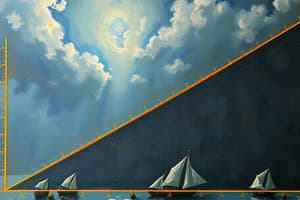Podcast
Questions and Answers
What does the relationship between Average Cost (AC) and Marginal Cost (MC) indicate when AC is at a minimum?
What does the relationship between Average Cost (AC) and Marginal Cost (MC) indicate when AC is at a minimum?
- MC is equal to AC. (correct)
- MC is greater than AC.
- MC is less than AC.
- MC does not affect AC.
In the context of production, what does the Law of Diminishing Marginal Productivity state?
In the context of production, what does the Law of Diminishing Marginal Productivity state?
- Input costs are irrelevant in determining productivity.
- Adding more of a variable input will eventually lead to lower per-unit output. (correct)
- More inputs always increase output proportionally.
- Marginal productivity continues to increase indefinitely with added inputs.
Which of the following best describes economic profit?
Which of the following best describes economic profit?
- Revenue generated from hard costs only.
- Total revenue minus total fixed cost.
- Total revenue minus total variable cost.
- Total revenue minus both explicit and implicit costs. (correct)
What is the significance of plotting total revenue, total variable cost, and total fixed cost?
What is the significance of plotting total revenue, total variable cost, and total fixed cost?
What is opportunity cost in the context of production?
What is opportunity cost in the context of production?
What does the term 'opportunity cost' signify in the context of owner-supplied resources?
What does the term 'opportunity cost' signify in the context of owner-supplied resources?
Which components make up the economic cost of a firm?
Which components make up the economic cost of a firm?
How is economic profit calculated?
How is economic profit calculated?
What distinguishes fixed costs from sunk costs in a business context?
What distinguishes fixed costs from sunk costs in a business context?
Which of the following best describes implicit costs?
Which of the following best describes implicit costs?
In the short run, what components does total cost consist of?
In the short run, what components does total cost consist of?
What happens to variable costs in the short run when production levels change?
What happens to variable costs in the short run when production levels change?
If a manager returns a railcar after one month for a Rs.10,000 lease with a repayment of Rs.4,000, what is the sunk cost associated with it?
If a manager returns a railcar after one month for a Rs.10,000 lease with a repayment of Rs.4,000, what is the sunk cost associated with it?
In which stage of production is the Marginal Product of Labor (MPL) greater than Average Product of Labor (APL) but still positive?
In which stage of production is the Marginal Product of Labor (MPL) greater than Average Product of Labor (APL) but still positive?
What does the Law of Diminishing Marginal Productivity state regarding MPL and APL in Stage 3?
What does the Law of Diminishing Marginal Productivity state regarding MPL and APL in Stage 3?
What equation represents the long run production function?
What equation represents the long run production function?
Which of the following correctly defines opportunity cost in production?
Which of the following correctly defines opportunity cost in production?
Which resource type is characterized as being owned by others and purchased or rented by firms?
Which resource type is characterized as being owned by others and purchased or rented by firms?
What does the term 'explicit cost' refer to in economic terms?
What does the term 'explicit cost' refer to in economic terms?
What can lead to returns to scale in production?
What can lead to returns to scale in production?
In which stage of production does a producer typically operate, characterized by a convex iso-quant?
In which stage of production does a producer typically operate, characterized by a convex iso-quant?
Flashcards are hidden until you start studying
Study Notes
Opportunity Cost
- Opportunity cost represents the potential returns lost when resources are utilized internally instead of being sourced externally.
- Implicit cost is the non-monetary opportunity cost associated with using a firm's own resources.
Economic Profit
- Economic profits calculated as the difference between Total Revenue and the sum of Explicit and Implicit Costs.
- It can be expressed in the form: Economic Profit = Accounting Profit - Implicit Cost.
Firm's Cost in Short Run
- Cost structure in the short run: Total Cost = Fixed Cost + Variable Cost.
- Fixed Cost remains constant regardless of production levels, related to the hiring of fixed inputs.
- Variable Cost fluctuates with production levels, linked to the hiring of variable inputs.
Fixed Cost and Sunk Cost
- Fixed Cost is recoverable if production ceases while Sunk Cost is irretrievable and represents losses incurred.
- Example: Leasing a railcar; Rs. 10,000 total fixed cost and Rs. 6,000 sunk cost (after one month) based on lease terms.
Stages of Production
- Stage 1: Marginal Product of Labor (MPL) exceeds Average Product of Labor (APL) and both are positive.
- Stage 2: APL is greater than MPL, both remain positive; optimal production occurs here.
- Stage 3: MPL exceeds APL but MPL becomes negative, indicating diminishing returns.
Long Run Production Function
- Production function represented as Q = f(L, K) where Q is output based on labor (L) and capital (K).
- The Marginal Rate of Technical Substitution of Labor for Capital (MRTSLK) indicates efficiency in input use.
- Iso-quants represent combinations of inputs producing the same output; a convex iso-quant indicates productive efficiency.
Return to Scale
- Return to scale describes how output changes as all inputs change proportionately.
- Factors influencing return to scale include division of labor, specialization, and managerial challenges, such as inventory control.
Cost Function
- Opportunity cost related to production considers both market-supplied resources (hired, rented) and owner-supplied resources.
- Total economic cost equals the cumulative opportunity cost of both categories of resources.
- Explicit costs are direct monetary payments for market-supplied inputs.
Relationship Between Costs
- Average Cost (AC) is derived from fixed and variable costs associated with production.
- Marginal Cost (MC) reflects the change in total cost from producing one more unit, calculated using cost function derivatives.
Cost Curves
- When Average Cost is minimized, it equals Marginal Cost indicating efficiency in resource allocation.
- Graphical representation includes total revenue, total variable costs, total fixed costs, and total profit to analyze profitability.
Studying That Suits You
Use AI to generate personalized quizzes and flashcards to suit your learning preferences.




